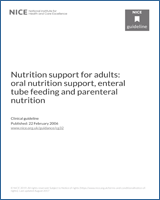2.1. Introduction
The purpose of this guideline is to present evidence and guidance related to nutrition support. In view of the problems related to studies of nutritional intervention (described in section 1.12), the Guideline Development Group (GDG) agreed to base some of the recommendations on principles derived from understanding the causes and effects of malnutrition in patients. This chapter covers these issues.
2.2. The causes of malnutrition
The main causes of malnutrition can be categorised under four headings (summarised in ):
Factors contributing to disease related malnutrition.
The relative importance of each class of problem varies and multiple factors often occur simultaneously. Physical factors, usually associated with illness, are the predominant cause of malnutrition in UK adults, although psychosocial issues have significant effects on dietary intake in some groups (e.g. the socially isolated, the bereaved, poor quality diets in low income groups and some older subjects). Since malnutrition both predisposes to disease () and is simultaneously an outcome of disease, patients may enter a downward spiral of ill-health due to malnutrition-disease interactions.
2.3. The effects of malnutrition
Malnutrition detrimentally effects physical function, psychosocial well-being and the outcome of disease. It can affect every system and tissue of the body 185,335, see .
Some physical and psycho-social effects of malnutrition.
2.4. The prevalence of malnutrition
There are many different anthropometric, clinical and biochemical criteria that have been used to assess malnutrition and these have resulted in widely varying reports of its prevalence. One of the simplest criteria is current weight status (e.g. body mass index; BMI). The proportion of underweight adults (BMI<20 kg/m2) in the UK varies considerably according to care setting: 10–40% in hospitals and care homes; ≤ 5% in the general population at home, and >10% in those at home with chronic diseases of the lung and gastrointestinal tract, or those who have had surgery in the previous 6 weeks. The ‘Malnutrition Universal Screening Tool’ (‘MUST’)94, which incorporates both current weight status and unintentional weight loss, has identified more than 10% of the general population aged 65 years and over as being at medium or high risk of malnutrition92–94,336. In hospitalised patients, the same degree of risk is seen in 10–60% depending on medical condition and patients’ age. Similar very high prevalence’s of nutritional risk are seen in residents of care homes but although most malnutrition is found in the community (>95%), most malnutrition related expenditure occurs in hospital9,87. However, both care settings make a substantial contribution to total costs.
The prevalence of individual nutrient deficiencies is also disturbing, especially in older subjects. For example, in people aged 65 years and over109, folate deficiency affects 29% of those who are “free living” (8% in severe form) and 35% of those in institutions (16% in severe form). Similarly, vitamin C deficiency in such people affects 14% of those who are free living (5% in a severe form) and 40% of those in institutions (16% in severe form). Nutrient deficiencies and protein-energy malnutrition commonly coexist335.
2.5. Principles underlying intervention
The difficulties inherent in nutrition support mean that there is little hard evidence to assist with decisions on how and when to treat patients who are either malnourished or at risk of becoming so. However, sensible approaches can be derived from understanding 3 types of observations:
Cross-sectional studies suggest that nutritionally related problems are likely to occur in individuals who are thin or who have recently lost weight
94,335,336 e.g. those with BMIs of <20 kg/m2 and especially <18.5 kg/m2 and/or those who have recently lost >5% of their usual body weight, especially those who have lost >10%.
Studies in healthy volunteers show that measures such as muscle function
203,335 decline within a few days of complete starvation, and after more than 5–7 days of little or no intake there is significant detriment in several bodily functions including many of those listed in . These ill effects reverse promptly with the provision of adequate feeding.
Studies in malnourished patients show rapid functional benefits when adequate feeding is provided. These changes can occur well before the weight lost has been regained (e.g. malnourished patients have low collagen deposition rates in surgical wounds but show improved deposition within days of receiving nutrition support
374).
With these observations in mind, good nutrition should benefit both those who are already overtly malnourished in terms of BMI or recent unintentional weight loss and those who are developing nutritional risks by having eaten little or nothing or be likely to eat little or nothing for over 5 days. In addition, nutrition support can often provide simple direct benefits by:
Keeping patients who are eating inadequately, alive for long enough for specific medical or surgical interventions to take effect.
Making malnourished patients feel better, improving their ability to cope with ill-health.
Maintaining strength through patients’ illnesses so that their recuperation is shortened and they are less susceptible to further problems.
Providing long-term support for those patients with chronic inability to eat, drink or absorb adequately.
The principles above underlie many of the recommendations proposed in these Guidelines. They are also in keeping with physical, psychological and social improvements that occur during repletion185.


